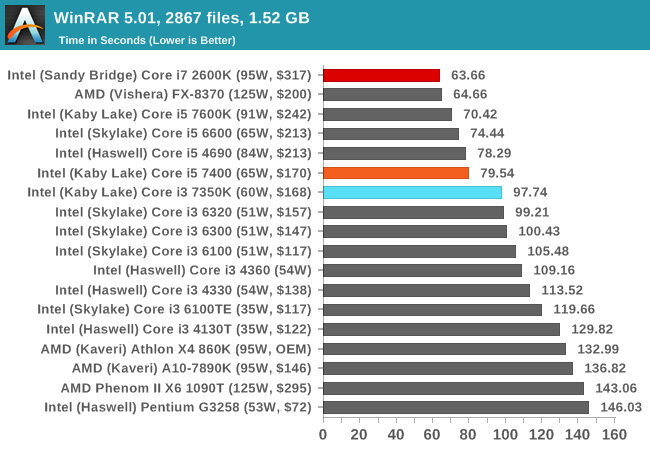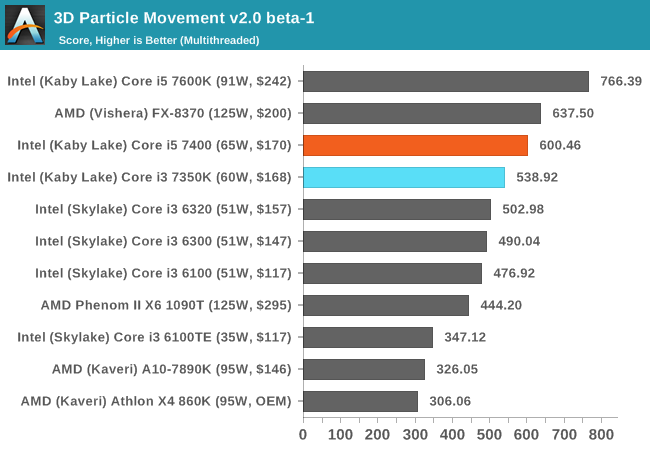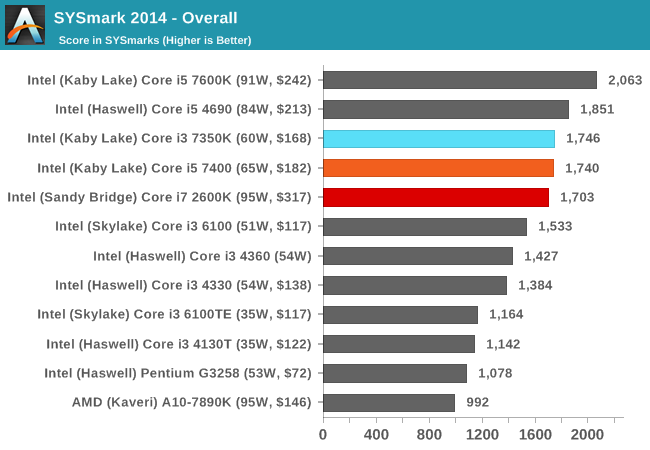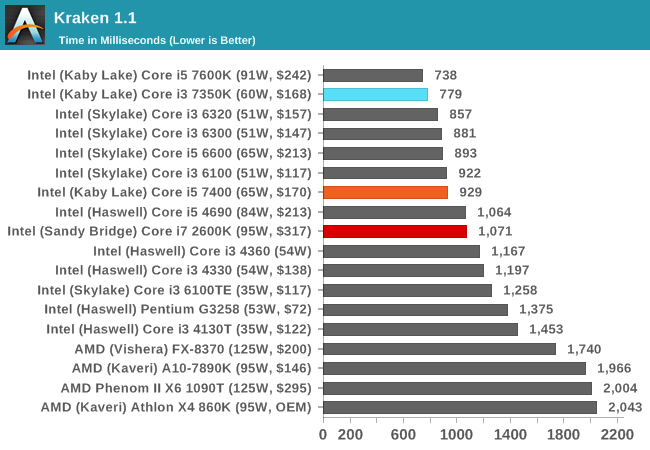The Intel Core i3-7350K (60W) Review: Almost a Core i7-2600K
by Ian Cutress on February 3, 2017 8:00 AM ESTOffice Performance
The dynamics of CPU Turbo modes, both Intel and AMD, can cause concern during environments with a variable threaded workload. There is also an added issue of the motherboard remaining consistent, depending on how the motherboard manufacturer wants to add in their own boosting technologies over the ones that Intel would prefer they used. In order to remain consistent, we implement an OS-level unique high-performance mode on all the CPUs we test which should override any motherboard manufacturer performance mode.
All of our benchmark results can also be found in our benchmark engine, Bench.
Dolphin Benchmark: link
Many emulators are often bound by single thread CPU performance, and general reports tended to suggest that Haswell provided a significant boost to emulator performance. This benchmark runs a Wii program that ray traces a complex 3D scene inside the Dolphin Wii emulator. Performance on this benchmark is a good proxy of the speed of Dolphin CPU emulation, which is an intensive single core task using most aspects of a CPU. Results are given in minutes, where the Wii itself scores 17.53 minutes.

The 7350K, with a high single thread frequency, easily surpasses the i5 and i7-2600K here. That being said, there's a slight difference to the Skylake i3, perhaps down to various generation specific code differences.
WinRAR 5.0.1: link
Our WinRAR test from 2013 is updated to the latest version of WinRAR at the start of 2014. We compress a set of 2867 files across 320 folders totaling 1.52 GB in size – 95% of these files are small typical website files, and the rest (90% of the size) are small 30 second 720p videos.

WinRAR is more geared towards a variable threaded environment but also memory speed. The fact that the Core i5 is above the Core i3 shows that having actual cores helps, regardless of frequency - the additional hyperthreads for the Core i7-2600K also gives it the win, despite the memory frequency difference.
3D Particle Movement v2
3DPM is a self-penned benchmark, taking basic 3D movement algorithms used in Brownian Motion simulations and testing them for speed. High floating point performance, MHz and IPC wins the day. This is the second variant of this benchmark, fixing for false sharing in the first version, and lending itself to better multithreaded performance.

3DPMv2 is still new, so we don’t have too many results for it so far - but again this is another situation where having actual cores helps. This is typically when the threads are 'heavy', i.e. spill out into various caches and require more than 1/2 the cache shared within a core each. In the case of the Kaby Lake, this means that each core has 32KB of L1 - or 32KB per thread for the i5 but only 16KB per thread in the i3.
SYSMark 2014
Engineered by BAPco (to which Intel is a consortium member), this set of tests are designed to be an office/data/media/financial range of tests using common well-known CAD, image editing, web browsing and other tools to put out a score, where a score of 1000 is attributed to an old Core i3 using a mechanical harddrive. Here we report the overall score, however the test breakdowns can be found in Bench.

Because SYSMark is a variety of tests that rely on response and throughput, here is where the Core i3 comes into play over the i5 and i7-2600K. With the i5 it's about equal, but the years of IPC increases put the i7-2600K now behind the Kaby i3.
Web Benchmarks
On the lower end processors, general usability is a big factor of experience, especially as we move into the HTML5 era of web browsing. For our web benchmarks, we take well-known tests with Chrome as installed by SYSMark as a consistent browser.
Mozilla Kraken 1.1

Kraken favors high frequency and IPC, so the i3 takes a large lead over the i7-2600K for this sort of workload.










186 Comments
View All Comments
silverblue - Saturday, February 4, 2017 - link
It's a bit weird, but most of them are within margin of error.WoodyBL - Saturday, February 4, 2017 - link
Am I the only one noticing that the i5-4690 was beating the i5-7600k in a lot of benchmarks? I'm having a hard time processing how that was even possible...fanofanand - Sunday, February 5, 2017 - link
Wasn't the 4690 Devil's Canyon? Similar IPC higher clocks I would assume. Most of the changes lately have been hardware decoders/encoders and I/o changes. Intel takes baby steps because it can, hopefully that changes with Ryzen.WoodyBL - Saturday, February 4, 2017 - link
Am I the only one noticing that the i5-4690 was beating the i5-7600k in a lot of benchmarks? I'm having a hard time processing how that was even possible...yankeeDDL - Saturday, February 4, 2017 - link
Glad to see that my 2 years old A10 still trashes anything Intel on integrated graphics.Gothmoth - Saturday, February 4, 2017 - link
no wonder intel is not selling to consumers, complaining about stagnation.the money they make comes from enterprise i guess.
i have not updated my sandy bridge for 6 years.
and i will not until intel gives me a reason.. this is only babysteps.
i had to cash out 1200 euro for a new mobo, cpu, ram, cooler... and for what.... 30% more performance..... meh
TelstarTOS - Saturday, February 4, 2017 - link
"Responsiveness? Top class."No way. It will suck in heavy multitasking.
synth0 - Sunday, February 5, 2017 - link
This is how good a 2011 chip really is!This shows there really isn't much sense to upgrade a PC anymore, and with time it will get even less sense to invest money for an upgrade. What will be in 2024? Are we entering into a stalemate in the PC area?
lopri - Sunday, February 5, 2017 - link
An excellent review but I would rather get a 7600K. Oh, wait. I already have something similar: 2600K.Bullwinkle J Moose - Sunday, February 5, 2017 - link
"The Intel Core i3-7350K (60W) Review: Almost a Core i7-2600K"---------------------------------------------------------------------------------------
.....and not even CLOSE to a Sandy Bridge!
Can the Intel Core i3-7350K use my Optical port in DRM crippled Windows 10 for Audio Production?
Show me how!
Can I record what I hear on the desktop with the DRM crippling API's found in Windows Vista / 7 / 8 and 10 ?
Show me how!
Will it boot "directly" to Windows XP faster than I can on my 35 watt dualcore Sandy Bridge (3-seconds on a Samsung 850 Pro SSD) so I CAN use my optical ports and record whatever I want without a DRM crippled Spyware Platform, or do the new motherboards prevent me from booting to a NON-crippled O.S. like my copy of Windows XP?
Well?
Should I "upgrade" to a crippled platform that prevents me from doing ANYTHING I want to do, but allows me to do only what Microsoft graciously allows me to do?
........ and explain to me again why I should pay more for my own enslavement?